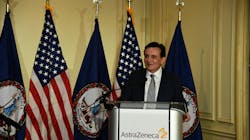AstraZeneca pledges $50B investment in US manufacturing, R&D amid Trump tariff threat
Cambridge, U.K.-based drugmaker AstraZeneca announced that it will invest $50 billion in manufacturing and R&D in the United States by 2030, as the company looks to reach its goal of $80 billion in revenue with 50% generated in the U.S.
The $50 billion investment includes a new multibillion-dollar manufacturing facility in Virginia that will produce small molecules, peptides and oligonucleotides for AstraZeneca’s weight management and metabolic portfolio, including oral GLP-1, baxdrostat, oral PCSK9 and combination small molecule products.
The Virginia drug substance facility, which will use AI, automation, and data analytics, will be AstraZeneca’s largest single manufacturing investment, according to the company. Currently, the U.S. is the drugmaker’s biggest market and is home to 19 manufacturing, R&D, and commercial sites.
The $50 billion investment in the U.S. over the next five years also includes: an expansion of the company’s R&D facility in Gaithersburg, Maryland; an R&D center in Kendall Square, Cambridge, Massachusetts; cell therapy manufacturing facilities in Rockville, Maryland and Tarzana, California; as well as continuous manufacturing expansion in Mount Vernon, Indiana and specialty manufacturing expansion in Coppell, Texas.
CEO Pascal Soriot in a statement said the announcement “underpins our belief in America’s innovation in biopharmaceuticals and our commitment to the millions of patients who need our medicines in America and globally.”
In November 2024, AstraZeneca announced a $3.5 billion investment to expand its U.S. manufacturing and R&D capabilities, set for completion by the end of 2026. The capital expenditure includes $2 billion for new projects, including a next-generation biologics manufacturing facility in Maryland, cell therapy manufacturing facilities on both the East and West Coasts, as well as specialty manufacturing operations in Texas.
During the company’s first-quarter earnings call in April 2025, Soriot made the case that the potential impact of tariffs on the minority of medicines imported from Europe “would be time-limited, as we are shifting manufacturing of these medicines to sites in the U.S.”
On the Q1 call, CFO Aradhana Sarin expressed caution about AstraZeneca committing to additional capital expenditure investments in the U.S. beyond 2025. However, earlier this month, President Donald Trump threatened to impose up to a 200% tariff on pharmaceuticals imported to the U.S., as part of his administration’s strategy to pressure drugmakers to increase domestic manufacturing of medicines.
In AstraZeneca’s Monday press release announcing its $50 billion U.S. investment, Commerce Secretary Howard Lutnick said in a statement that the company has “made the decision to bring substantial pharmaceutical production to our shores” and “will ensure medicine sold in our country is produced right here.”
However, over the last few years, AstraZeneca has been building a broad manufacturing network covering not just the U.S. but Europe and China, with 31 production sites globally and dual-source supply for most of its medicines.
In March, AstraZeneca unveiled a $2.5 billion plan for R&D, biotech and manufacturing expansion in Beijing — the company’s first vaccine manufacturing site in China.
About the Author
Greg Slabodkin
Editor in Chief
As Editor in Chief, Greg oversees all aspects of planning, managing and producing the content for Pharma Manufacturing’s print magazines, website, digital products, and in-person events, as well as the daily operations of its editorial team.
For more than 20 years, Greg has covered the healthcare, life sciences, and medical device industries for several trade publications. He is the recipient of a Post-Newsweek Business Information Editorial Excellence Award for his news reporting and a Gold Award for Best Case Study from the American Society of Healthcare Publication Editors. In addition, Greg is a Healthcare Fellow from the Society for Advancing Business Editing and Writing.
When not covering the pharma manufacturing industry, he is an avid Buffalo Bills football fan, likes to kayak and plays guitar.
